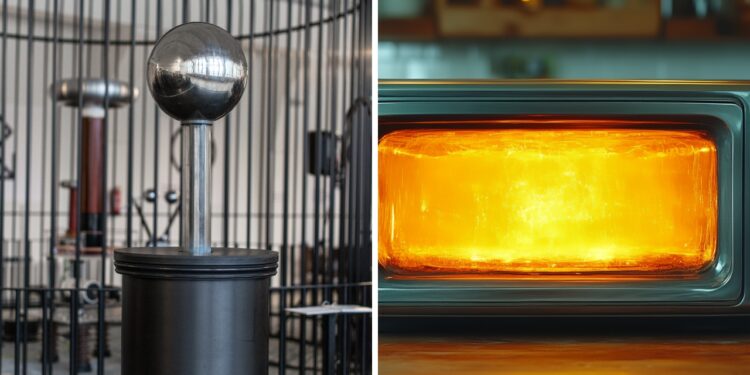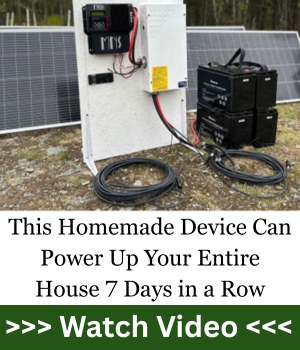In the world of prepping and emergency preparedness, protecting your electronics from electromagnetic pulses (EMPs) is essential. One common question that arises is: “Is a microwave oven a Faraday cage?” This article takes an in-depth look at the science behind Faraday cages, how microwave ovens are constructed, and whether these everyday appliances can be repurposed to shield sensitive electronics during a crisis.
What Is a Faraday Cage?
A Faraday cage is an enclosure made of conducting material that blocks external static and non-static electric fields by channeling electricity along and around, rather than through, the enclosure. The concept is named after Michael Faraday, who invented the device in 1836. In practical terms, a properly constructed Faraday cage protects the items inside from electromagnetic interference (EMI), lightning strikes, and EMPs by redistributing incoming electromagnetic energy.
Related: What No One Told You About Faraday Cages
Key aspects of a Faraday cage include:
-
Conducting Material: Typically metal, which reflects or absorbs incoming electromagnetic waves.
-
Continuous Enclosure: Gaps and seams must be minimized because any break in the enclosure can let electromagnetic energy inside.
-
Grounding: While not always necessary for blocking RF energy, grounding can help dissipate energy safely, especially during lightning strikes.
How Do Microwave Ovens Work?
Microwave ovens are designed to heat food using electromagnetic waves—specifically, microwaves at a frequency of about 2.45 GHz. To prevent these microwaves from escaping the oven (and causing harm or interference), microwave ovens are constructed with a metal body and a metal mesh on the door. The mesh, featuring small perforations, is engineered to be smaller than the wavelength of the microwaves, effectively reflecting them back into the oven cavity.
Extra Reading: 15 Things You Must Learn To DIY Before An EMP
This design offers a degree of shielding. When you place a device (like a cell phone) inside and close the microwave door, it typically loses its signal. This demonstrates that the oven’s construction does prevent high-frequency signals from escaping the cavity.
Can a Microwave Oven Act as a Faraday Cage?
At first glance, the design of a microwave oven does resemble a Faraday cage. Its metal exterior and finely perforated door mesh suggest that, like a true Faraday cage, it should block electromagnetic signals from penetrating into or escaping from the interior. However, while microwave ovens do provide some shielding, several factors determine whether they can serve as an effective Faraday cage in a survival situation:
Strengths of the Microwave Oven as a Shield
-
Metal Construction: The metal walls of a microwave are, by their very nature, capable of deflecting electromagnetic waves.
-
Mesh Design: The perforated door prevents microwaves (around 12.2 cm in wavelength) from escaping, effectively containing most of the electromagnetic energy inside the oven.
-
Practical Demonstrations: Simple tests, such as placing a radio or cellphone inside the microwave and closing the door, often result in signal loss, indicating an initial level of shielding.
Limitations and Weak Points
Despite its seemingly Faraday-like design, which you can actually make yourself, a microwave oven has several shortcomings when considered as a protection device against EMPs or other disruptive electromagnetic events:
-
Seam and Gasket Vulnerabilities: Microwave ovens are not built with a continuous metal surface; there are seams where the door and body meet, and these gaps can compromise the shield’s integrity. Even a small opening may allow harmful electromagnetic pulses to penetrate.
-
Frequency Limitations: Microwave ovens are engineered to block specific frequencies (centered around 2.45 GHz). An EMP or other broad-spectrum electromagnetic disturbance contains a wide range of frequencies. The oven’s design may not be optimized to block these other frequencies effectively.
-
Lack of Grounding: Unlike purpose-built Faraday cages that sometimes incorporate grounding mechanisms to divert electrical energy away from the interior, microwave ovens are generally not grounded in a way that enhances their shielding capabilities.
-
Structural Integrity: Microwave ovens are designed for cooking, not long-term storage of sensitive electronics. Their internal components and the mesh door can degrade over time, making them less reliable under extreme conditions.
If you need a fast solution that will protect some of your electronics, including your generator, it is generally safer to consider buying an EMP Cloth.
Real-World Considerations
For most preppers, the idea of using a microwave oven as a stopgap Faraday cage might be tempting in an emergency. However, it’s important to understand that while a microwave can offer limited protection in a pinch, it is not a substitute for a purpose-built Faraday cage. Simple experiments might show that it blocks your cell phone’s signal, but that does not guarantee it will offer robust protection against the high-energy, broad-spectrum signals produced by an EMP.
You Should Also Read: Prepping For An EMP On A Budget
Preppers looking for reliable EMP protection should consider more dependable methods, such as metal ammo cans lined with cardboard, specialized EMP bags, or custom-built Faraday cages that ensure continuous, well-grounded, and gap-free construction. These alternatives are designed specifically for shielding sensitive electronics and can offer peace of mind when the grid goes down.
Final Thoughts
So, is a microwave oven a Faraday cage? In a technical sense, a microwave oven does provide some level of electromagnetic shielding due to its metal construction and mesh design. However, its limitations—such as vulnerabilities at the seams, frequency-specific design, and lack of proper grounding—mean it should not be relied upon as a robust EMP protection solution.
For preppers, understanding these nuances is crucial. While a microwave may work temporarily in a survival scenario to block some signals, investing in or constructing a dedicated Faraday cage is the best way to protect your vital electronics when the stakes are high.
Staying informed and testing your survival strategies before you need them can make all the difference when disaster strikes.
You may also like:
 EMP Movies That Do More Harm Than Good
EMP Movies That Do More Harm Than Good
DIY EMP-Proof Projects You Need on Your Property Before It’s Too Late (Video)
EMP Proof Cloth. Easy EMP Protection For Your Car And Generator














